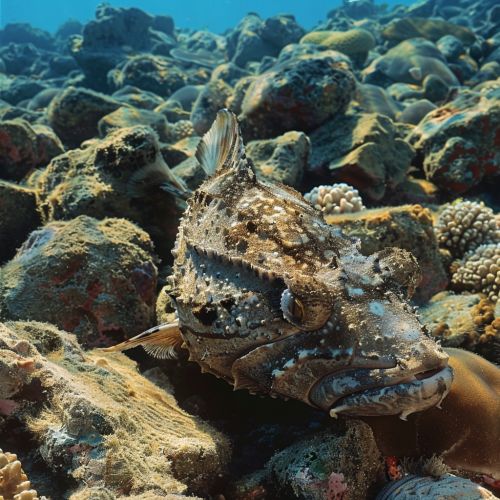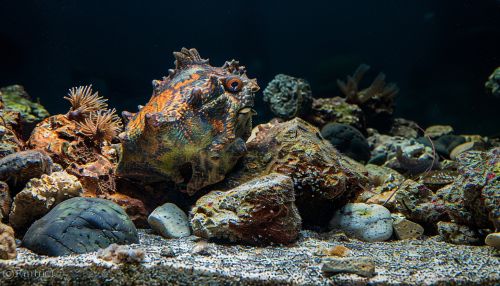Stonefish
Introduction
The Stonefish (Synanceiidae) is a family of venomous marine fish that are known for their unique appearance and potent venom. They are among the most venomous fish in the world and are found in the coastal regions of the Indo-Pacific.
Description
Stonefish are named for their unusual shape and coloration, which resembles a rock or stone. They have a robust, compressed body and a large, upturned mouth. The skin often has a warty appearance and is typically covered in encrustations of algae and other marine organisms, further enhancing their camouflage.


The dorsal fin of the stonefish contains 13 venomous spines. Each spine is associated with a pair of venom glands, and the venom is released when pressure is applied to the spine. The venom contains a mix of proteins, enzymes, and other compounds that can cause severe pain, cardiovascular collapse, and in rare cases, death.
Distribution and Habitat
Stonefish are found in the warm, tropical waters of the Indo-Pacific, from the Red Sea and the coasts of Africa to the Pacific islands and Australia. They are typically found in shallow waters, often hiding among rocks, coral, and rubble on the ocean floor. Stonefish are also known to inhabit estuaries and can even survive in freshwater for a limited period.
Behavior and Diet
Stonefish are ambush predators that rely on their excellent camouflage to hide from potential prey. They typically remain motionless, buried in the sand or hidden among rocks, waiting for small fish or invertebrates to pass by. When prey comes within range, the stonefish can strike with lightning speed, swallowing the prey whole.
Reproduction
Stonefish reproduction involves external fertilization. The female releases her eggs into the water, which are then fertilized by the male. The eggs float freely in the water and hatch after a few days, releasing tiny, transparent larvae. The larvae drift with the ocean currents, feeding on plankton until they are large enough to settle on the ocean floor and begin life as juvenile stonefish.
Human Interactions
Due to their venomous spines, stonefish pose a significant risk to humans. Most stings occur when a person accidentally steps on a stonefish, mistaking it for a rock or piece of coral. Stonefish stings are extremely painful and can be fatal if not treated promptly. Treatment typically involves immersion of the affected limb in hot water to denature the venom, followed by administration of antivenom if available.
Despite the risks, stonefish are also of interest to humans for other reasons. They are considered a delicacy in some cultures and are often displayed in public aquariums due to their unique appearance and behavior.
Conservation
While stonefish are not currently considered endangered, they face threats from habitat destruction and pollution. Coral reef habitats, in particular, are vulnerable to the impacts of climate change, including ocean acidification and rising sea temperatures.
